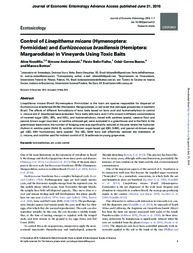Control of linepithema micans (hymenoptera: formicidae) and eurhizococcus brasiliensis (hemiptera: margarodidae) in vineyards using toxic baits.
Control of linepithema micans (hymenoptera: formicidae) and eurhizococcus brasiliensis (hemiptera: margarodidae) in vineyards using toxic baits.
Author(s): NONDILLO, A.; ANDZEIEWSKI, S.; FIALHO, F. B.; BUENO, O. C.; BOTTON, M.
Summary: Linepithema micans (Forel) (Hymenoptera: Formicidae) is the main ant species responsible for dispersal of Eurhizococcus brasiliensis (Wille) (Hemiptera: Margarodidae), a root scale that damages grapevines in southern Brazil. The effects of different formulations of toxic baits based on boric acid and hydramethylnon to control L. micans and E. brasiliensis were evaluated. Toxic baits with boric acid (1.0%) mixed in different concentrations of inverted sugar (20%, 30%, and 40%), and hydramethylnon, mixed with sardines (paste), cassava flour and peanut, brown sugar (sucrose), or sardine oil-based gel, were evaluated in a greenhouse and in the field. In the greenhouse experiment, the number of foraging ants was significantly reduced in the pots where the hydrame- thylnon in sardine paste (Solid S), sardine oil-brown sugar-based gel (GEL SAM), and peanut oil-brown-sugar gel (GEL AM) formulations were applied. The GEL SAM toxic bait effectively reduced the infestation of L. micans , and could be used for indirect control of E. brasiliensis on young grapevines. Keywords : hydramethylnon, ant, scale, control
Publication year: 2016
Types of publication: Journal article
Unit: Embrapa Grape & Wine
Observation
Some of Embrapa's publications are published as ePub files. To read them, use or download one of the following free software options to your computer or mobile device. Android: Google Play Books; IOS: iBooks; Windows and Linux: Calibre.
Access other publications
Access the Agricultural Research Database (BDPA) to consult Embrapa's full library collection and records.
Visit Embrapa Bookstore to purchase books and other publications sold by Embrapa.

